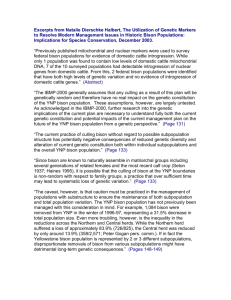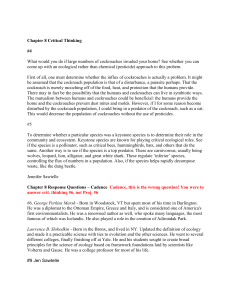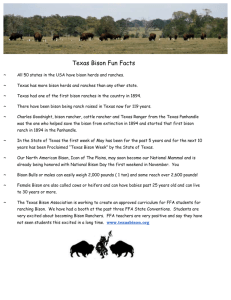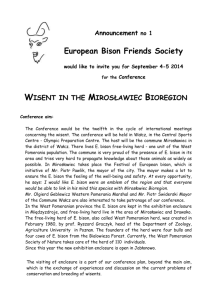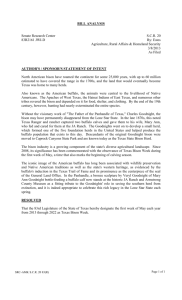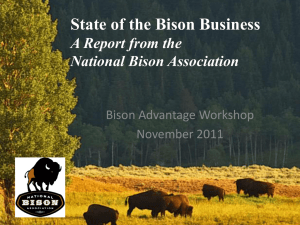Word Document, 62 KB, 16 pages
advertisement
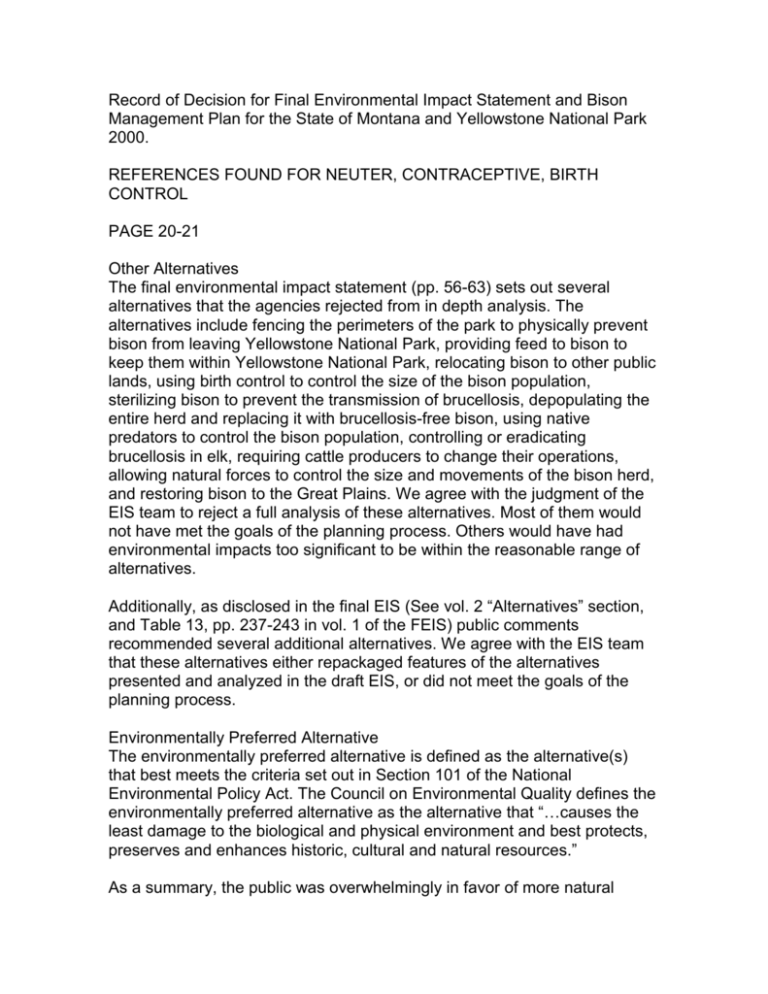
Record of Decision for Final Environmental Impact Statement and Bison Management Plan for the State of Montana and Yellowstone National Park 2000. REFERENCES FOUND FOR NEUTER, CONTRACEPTIVE, BIRTH CONTROL PAGE 20-21 Other Alternatives The final environmental impact statement (pp. 56-63) sets out several alternatives that the agencies rejected from in depth analysis. The alternatives include fencing the perimeters of the park to physically prevent bison from leaving Yellowstone National Park, providing feed to bison to keep them within Yellowstone National Park, relocating bison to other public lands, using birth control to control the size of the bison population, sterilizing bison to prevent the transmission of brucellosis, depopulating the entire herd and replacing it with brucellosis-free bison, using native predators to control the bison population, controlling or eradicating brucellosis in elk, requiring cattle producers to change their operations, allowing natural forces to control the size and movements of the bison herd, and restoring bison to the Great Plains. We agree with the judgment of the EIS team to reject a full analysis of these alternatives. Most of them would not have met the goals of the planning process. Others would have had environmental impacts too significant to be within the reasonable range of alternatives. Additionally, as disclosed in the final EIS (See vol. 2 “Alternatives” section, and Table 13, pp. 237-243 in vol. 1 of the FEIS) public comments recommended several additional alternatives. We agree with the EIS team that these alternatives either repackaged features of the alternatives presented and analyzed in the draft EIS, or did not meet the goals of the planning process. Environmentally Preferred Alternative The environmentally preferred alternative is defined as the alternative(s) that best meets the criteria set out in Section 101 of the National Environmental Policy Act. The Council on Environmental Quality defines the environmentally preferred alternative as the alternative that “…causes the least damage to the biological and physical environment and best protects, preserves and enhances historic, cultural and natural resources.” As a summary, the public was overwhelmingly in favor of more natural management of the bison herd, with minimal use of actions they felt more appropriate for livestock such as capture, test, slaughter, vaccinating, shooting, corralling, hazing, etc. They also indicated extremely strong support for the management and/or restriction of cattle rather than bison given a choice between the two. The public also supported the acquisition of additional land for bison winter range and/or the use of all public lands in the analysis area for a wild and free-roaming herd of bison. A large number of commentors also expressed opposition to lethal controls, and in particular the slaughter of bison. Alternative 2 would minimize human intervention, discontinue the use of capture, test and slaughter, focus on managing cattle rather than bison, and result in the largest area of acquired land for winter range. It also would offer the largest benefits to most environmental resources analyzed in the EIS, with alternative 3 offering some benefits to many of these same resources as well. The management emphasis and environmental advantages of alternative 2 are most consistent with the overwhelming majority of public comment. In addition, the benefits to environmental resources as analyzed in the FEIS as well as those analysis of Section 101 criteria indicate alternative 2 as environmentally preferred. Based on this combination of public commentary, FEIS analysis, and adherence to the principles of Section 101 of the National Environmental Policy Act, alternative 2 is identified as the environmentally preferred alternative. VOLUME 1, Final Environmental Impact Statement and Bison Management Plan for the State of Montana and Yellowstone National Park 2000. REFERENCES FOUND FOR NEUTER, CONTRACEPTIVE, BIRTH CONTROL SUMMARY PAGE IX-X Risk of Transmission. Scientists and researchers disagree on even some of the most basic factors influencing the risk of transmission. These include whether studies on cattle are applicable to bison, whether controlled studies are applicable in the field, and the best ways to conduct additional research to determine the risk of transmission. These disagreements and a paucity of information on brucellosis in bison make it impossible to quantify the risk of B. abortus transmission from bison (and elk, although this environmental impact statement does not analyze brucellosis in elk) in the Yellowstone area to domestic livestock. Instead, the agencies have identified factors that affect risk. They include the following: 1. The degree of association between potentially infectious and susceptible animals. Management actions emphasize separation to minimize risk. 2. The number and density of infectious animals in the host population. 3. The number of susceptible animals that may associate with infectious animals. 4. Environmental factors such as weather, sunlight, and other factors that determine the viability of the organism outside its host. 5. The class of the infectious animals. Because the disease is transmitted in cattle through ingestion of contaminated birth materials, pregnant bison are considered higher risk than other classes. 6. Vaccination and neutering reduce the transmission of the disease. 7. Some animals are naturally resistant to infection. Since bison and cattle are prevented from interacting under each of the alternatives in this environmental impact statement, it is the presence and persistence of bacteria in birth materials that are at issue in determining the risk of transmission. Research completed since the release of the Draft Environmental Impact Statement has direct bearing on this discussion. In one study, 30 known bison birth or abortion sites in the park from 1996 to 1998 were sampled. The B. abortus bacterium was isolated at two of those sites immediately following the birth or abortion event and persisted for a maximum of 18 days (Coffin, pers. comm.). Cook (1999) studied B. abortus strain RB51 on samples taken from the exposed surface of bovine fetuses in Wyoming under natural environmental conditions. While some environmental conditions may vary in Wyoming from those found in the impact area, Cook found that the bacteria were vulnerable to light and desiccation and concluded that by June, when cattle are scheduled to return to public grazing allotments in the impact area, as few as 4.7 days would be required to ensure the absence of any live bacteria. Under all alternatives, susceptible cattle would not be allowed to graze until a minimum of 30 days have elapsed since bison were hazed back into the park. V BACKGROUND PAGE 27-28 Under all alternatives, bison would be hazed off these lands and back into the park a minimum of 30 days prior to the return of cattle. In a separate study, Cook (1999) placed fetuses in various habitats within the Greater Yellowstone Area and found 90% are scavenged and disappear within 4 days, and the bulk of infectious material was removed by this process. The National Academy of Sciences (1998) concludes that “predation and scavenging by carnivores likely biologically decontaminates the environment of infectious B. abortus with an efficiency unachievable in any other way.” The National Academy of Sciences report confirms that the risk of B. abortus transmission from Yellowstone bison to cattle is low (NAS 1998). Although it is not possible to quantify this risk because many of the variables that define risk are unknown, it is possible to identify the various factors that affect risk and to qualitatively evaluate how alternative management approaches affect those factors. Important factors include the following: 1. Risk of transmission is affected by the degree of association between potentially infectious and susceptible animals. To become infected, a susceptible animal must come in contact with an infectious animal or discharges that contain a sufficient dose of viable Brucella organisms. Separation in space and time reduces the potential for transmission. In addition to separation that occurs as a result of management actions, separation may occur as a result of differences in behavior, habitat selection, geographic features, and distribution in response to weather. 2. The risk of B. abortus transmission increases as the number and density of infectious animals in the host population increases. Conversely, the risk is reduced when the number of infectious animals is lowered through reduction in animal crowding, reduction in population size, and vaccination. Cattle within the impact area are currently vaccinated. Modelling suggests that vaccinating bison is expected to substantially reduce seroprevalence. 3. The risk of transmission increases as the number of susceptible animals that may associate with infectious animals increases, and decreases as the number of animals that may be associated with infectious animals decreases. 4. The risk of transmission is affected by environmental factors. Outside its host, Brucella organisms have limited viability. Discharges remain infectious for longer periods during cold weather. Direct sunlight quickly kills the organism. Scavenging by wildlife reduces the occurrence of infectious tissues, but scavengers may also physically transport infectious tissues. 5. The risk of transmission is affected by the class of the infectious animals. The available evidence indicates that the primary risk of B. abortus transmission from bison to cattle is contamination resulting from abortions and birthing events by infected adult female bison. However, limited available data documents the presence of B. abortus organisms in bison semen. Therefore, the risk of transmission from bull bison, although logically small, cannot be entirely eliminated based on existing information. Neutered animals are unlikely to transmit the disease. 6. The risk of transmission may be reduced by vaccination, neutering, and herd management (such as separation of animals in time and space). 7. Some animals are naturally resistant to infection. Alternative Interpretation of Risk As noted above, there is considerable disagreement about the significance of brucellosis in bison, especially the degree to which bison pose a risk of brucellosis transmission to livestock. There is no definitive information with which to resolve this disagreement. The following information summarizes ideas discussed during development but not included in the paper on “Brucellosis in the Greater Yellowstone Area” (GYIBC 1997). SCOPING PROCESS AND PUBLIC PARTICIPATION PAGE 59-60 Control bison population numbers using current wildlife birth control methods. The purpose of actions proposed in this environmental impact statement is to maintain a wild, free-ranging bison population and maintain the brucellosis class-free status of Montana by ensuring a low potential risk of brucellosis transmission between bison and cattle. However, unlike this specific goal, contraception is broad-based and a nonspecific population control method. The latest (January 2000) bison count was 2,410 animals. However, as population sizes increase to a point where numbers management is important, the ability to effectively use contraception falls. Research has been done on using contraception as a technique to limit the growth of certain nonnative wildlife populations elsewhere in North America. A sixyear study of wild horses at Assateague Island National Seashore in Maryland showed promising results. However, researchers at Assateague indicated that a major factor in the success of that program was that they were dealing with a small population of animals (165 horses) confined to a relatively small island habitat (8,500 acres). Bison population control using contraceptives would be a highly technical program, requiring professional personnel and specialized supplies and equipment. Some contraceptive agents must be delivered by hand, requiring handling of the animals. Others could be delivered remotely (by hypodermic darting, for example), up to a distance of 50 yards. In both cases, bison could develop conditioned avoidance, making it increasingly difficult to administer the agent. Long-term effects of having a large number of nonreproducing animals in a herd are unknown. Hormonal contraception of females would suppress ovarian function, prevent estrous cycles, and reduce male attraction to females (McCullough et al. 1993). Immunocontraception does not prevent ovarian cycling, and males could be repeatedly attracted to females. The breeding season likely would be extended because of the polyestrous (multiple ovulation) nature of nonpregnant animals and could have physiological effects on males and females. It is also unknown if immunocontraception would affect the immune system of bison and potentially make them more susceptible to disease. For these reasons, contraception will not be considered as a population control strategy for bison in this environmental impact statement. To date, no free-ranging large mammal population has been effectively controlled using available contraception techniques (B. Garrott, Montana State University, pers. comm.). Aside from uncertainties as to effectiveness, “significant behavioral changes can be expected for all major contraceptive agents currently under investigation” (Garrott 1995). Contraceptive agents could disrupt family and social bonds and extend or alter breeding and birthing seasons (Garrott 1995). Furthermore, technology does not exist that effectively administers contraceptive agents to free-ranging populations of large mammals (Garrott 1995). For successful treatment, it is necessary to have an optimum combination of animals available, a proportion of these animals that can be successfully treated, and an efficacious treatment method. Currently available techniques are relatively ineffective (Garrott 1995) in free-ranging populations, spread over a large, geographically varied area. Using sterilization (neutering) as a means of controlling brucellosis in bison in Yellowstone National Park. Brucellosis is a disease usually affecting the reproductive tract of animals, causing abortions. It is transmitted primarily when noninfected animals come into physical contact with aborted materials or birthing products that harbor the Brucella organism. Sterilized female bison would be rendered harmless for any potential transmission of brucellosis given the biological circumstances for such transmission. Neutering, by whatever means and for whatever purpose, may alter the social interactions and behavior of bison, such as family bonds or the dominance of bulls during the rut. Sterilization, if done on a large scale, might have genetic influences on the population by eliminating pre-selected animals from the gene pool. And, neutering would not contribute to controlling migrations. For these reasons, neutering bison and returning them to Yellowstone National Park will not be considered further in the environmental impact statement, although changing cattle operations to run steers or spayed heifers is a part of alternatives 2 and 3. ENVIRONMENTAL CONSEQUENCES PAGE 514-516 RISK OF TRANSMISSION FROM WILDLIFE TO CATTLE — The issue of the risk of transmission from bison to cattle is central to an evaluation of the benefits and costs of the proposed alternatives. The NAS (1998) report notes (p. 43) that One of the most contentious issues — because it is key to determining the need for control of the disease in Greater Yellowstone Area wildlife — is the probability of transmission of brucellosis between freeroaming bison and domestic livestock. Nearly all parties to the controversy agree that the risk of transmission of brucellosis from bison to cattle in the Greater Yellowstone Area is small, but not zero. Defining small depends on whether transmission has occurred in the past and, if so, how often. That is key to determining the need to control brucellosis in bison. For purposes of the benefit-cost analysis regarding this issue, it is necessary to define the with- and without-plan risk of transmission. The reduction in risk is a benefit of the plan. First, with regard to “with-plan” risk, it appears to be approximately zero. All of the alternatives rely on temporal and spatial separation of cattle and the definition of a boundary beyond which bison will not be tolerated. The judgement of the NAS (1998) report is that “There is no risk of Brucella abortus transmission to cattle from bison if bison do not leave Yellowstone National Park.” Because bison are not permitted into areas with cattle or are removed from areas where cattle will graze following adequate temporal separation (approximately 45 days), the risk of transmission is near zero. All of the alternatives described here incorporate this spatial and temporal separation. For example, alternative 1 relies on strict border enforcement to keep bison and cattle separate. Sometimes in an environmental impact statement the “no-action” alternative provides for “no program.” Benefits are measured for a given alternative by comparison to this “no-program “ alternative. For this case the “no-action” alternative is the current interim plan which has been in place with some modification since 1996. Since the “no action” alternative essentially reduces the risk of transmission to near zero, and all other alternatives do likewise, there are no measurable benefits with regard to reductions in the risk of transmission for any of the alternatives. This anomaly has been noted by some commenters who responded to the Draft Environmental Impact Statement. To address the question of whether the proposed expenditures on protecting the Montana cattle industry from brucellosis are justified, it is necessary to identify some “without plan” situations that are possibly worth avoiding. The Draft Environmental Impact Statement identified factors that affect the risk of transmission (p. v): degree of association between potentially infectious and susceptible animals number and density of infectious animals number of susceptible animals environmental factors affecting viability of organism outside host class of infectious animals (pregnant bison are higher risk) vaccination and neutering some animals are naturally resistant It is noteworthy that the NAS report (1998) recognizes that “The risk of transmission is determined by the number of abortions that occur, the presence and survival of Brucella abortus in aborted tissues, and the exposure to a susceptible host.” For purposes of this analysis, the planning areas of interest for the “without plan” setting are the SMAs north and west of Yellowstone National Park and the planning period is 2000 to 2015. Estimating the bison population that would be wintering outside the park in the absence of a plan is problematic. The closest estimate would be the results from the stochastic model under alternative 2, which shows bison populations growing to a total of 5,246 animals by 2014, with 1,643 animals wintering on lands north and west of the park. However, this scenario includes substantial bison removals. With no removals and using an 8.2% annual growth rate, the population would reach about 8,000 animals by 2015, with an average of 1,500 bison wintering outside the park during the planning period (bison population estimates from the new stochastic model results were used in this analysis). The NAS (1998) study suggests a constant incremental growth model might be appropriate, which would lead to lower populations. This projection also relies on the general findings from the NAS report that natural regulation does not appear to limit bison populations in Yellowstone National Park, at least at the historical levels observed. As the study notes (NAS 1998) “The lack of stabilization of bison population growth over time since the natural regulation policy was adopted suggests that bison have expanded like a wave front across suitable habitat in [Yellowstone National Park] with little diminution until now they are pressing against the borders of Yellowstone National Park in winter.” An unanswered question is, “At what population level would some bison no longer return to the park in the summer?” With regard to other “without-plan” factors, the seroprevalence in bison is 30%–40%, the cattle population is potentially as high as 2,224 pairs (698 on allotments), calfhood vaccination of cattle in the SMAs is 100%, and the bison abortion rate is unknown. The NAS (1998) report cites only two known bison abortions in the last decade, but the probability of observing an abortion is probably quite low. A complicating factor is the presence of seroprevalent elk, which can reinfect bison or directly infect cattle. For the planning area, elk potentially mixing with cattle during pregnancy and birthing numbers 2,000 to 6,000, seroprevalence is low (1%– 2%), and the Northern elk herd abortion rate is unknown. These parameters are summarized in table 58. VOLUME 2, Final Environmental Impact Statement and Bison Management Plan for the State of Montana and Yellowstone National Park 2000. REFERENCES FOUND FOR NEUTER, CONTRACEPTIVE, BIRTH CONTROL PAGE 10 Issue 3: Sterilization of Bison A Comment: Immunocontraception is a feasible and humane alternative to hunting. Why was it eliminated? Response: This question is addressed in more detail in “Bison: Population,” issue 5 (maintaining population within stated objectives). In brief, in addition to the factors already cited in the Draft Environmental Impact Statement (see pp. 39–40), contraceptive agents could disrupt family and social bonds in the herd. Technology does not currently exist to administer them to freeranging populations of large mammals, and to date no such population has been effectively controlled using available contraceptive techniques (Garrott 1995). The final environmental impact statement text has been revised (see volume 1, “Purpose of and Need for Action: Scoping Process and Public Participation— Alternatives Suggested but not Analyzed”) to further explain reasons why wildlife birth control methods in this situation are not feasible and the adverse impacts to the bison herd they would cause. Representative Comment: 9100E B Comment: Population size is related to migrations, and sterilization would control population size. It should be considered in more depth. Response: Please see above (3A). Representative Comment: 15316Q PAGE 99 Issue 5: Maintaining Population within Stated Objectives C Comment: The bison population size should be controlled by sterilization or immunocontraception, rather than by lethal means. Response: The Draft Environmental Impact Statement (pp. 39–40) addresses some of the difficulties in considering contraception or sterilization as population control techniques. To date, no free-ranging large mammal population has been effectively controlled using available contraception techniques (B. Garrott, Montana State University, pers. comm.). Aside from uncertainties as to their effectiveness, “significant behavioral changes can be expected for all major contraceptive agents currently under investigation”(Garrott 1995). Contraceptive agents could disrupt family and social bonds and extend or alter breeding and birthing seasons (Garrott 1995). Furthermore, the technology does not currently exist by which to effectively administer contraceptive agents to free-ranging populations of large mammals (Garrott 1995). The need for an optimum combination of availability of animals to treat, the proportion of animals that can be successfully treated, and the efficacy of the method used is likely to render currently available techniques relatively ineffective (Garrott 1995) in a free-ranging population spread over a large, geographically varied area. For these reasons, this method of population control has not been considered further as a means for limiting bison population size. Representative Comment: 46C PAGE 167 Issue 6: Risk Management A Comment: The agencies should sterilize female bison that are capable of transmitting brucellosis. Response: The Draft Environmental Impact Statement addresses some of the difficulties in considering contraception or sterilization as a population control technique (see DEIS, p. 40). Similar difficulties are anticipated in attempting to use sterilization as a risk management technique. Aside from uncertainties alto effectiveness, “significant behavioral changes can be expected for all major contraceptive agents currently under investigation” (Garrott 1995). Contraceptive agents could disrupt family and social bonds and extend or alter breeding and, therefore, birthing seasons (Garrott 1995). Furthermore, the technology does not currently exist by which to effectively administer contraceptive agents to free-ranging populations of large mammals (Garrott 1995). The need for an optimum combination of available animals to treat, the proportion of animals that can be successfully treated, and the efficacy of the method used is likely to render currently available techniques relatively ineffective in a free-ranging population spread over a large, geographically varied area (Garrott 1995). Furthermore, targeting young, reproductive females, which are the animals most likely to be infectious (Roffe et al. 1999), could have serious impacts on population numbers and composition. For these reasons, this method has not been considered further as a means for limiting bison population size or for managing transmission risk. Representative Comment: 13442D PAGE 317 Issue 5: National Park Service Authority K Comment: A vaccination program for bison in Yellowstone National Park would seemingly be inconsistent with NPS natural regulation mandates. Response: The eradication of an exotic organism, such as Brucella abortus, is consistent with NPS Management Policies. The National Park Service also uses vaccinations on wildlife to protect animals from disease (e.g., reintroduced wolves have been vaccinated for rabies and distemper) and to control populations (e.g., feral ponies on barrier islands have been vaccinated with a contraceptive). Representative Comment: 14714 PAGE 361 Issue 4: Specific Management Activities Were Identified as Cost-Effective or Costly B Comment: Sterilization (neutering) of bison is less costly. Response: The agencies identified this alternative in the public scoping process, considered its impacts and reasonableness, and eliminated it from further analysis (see volume 1, “Purpose of and Need for Action: Introduction — Need for Action” and “—Purpose of Action,” and volume 1, “Purpose of and Need for Action: Scoping Process and Public Participation — Objectives, Alternatives, and Issues from Public Comments (Alternatives Suggested but Not Analyzed).” Representative Comment: 7434B


